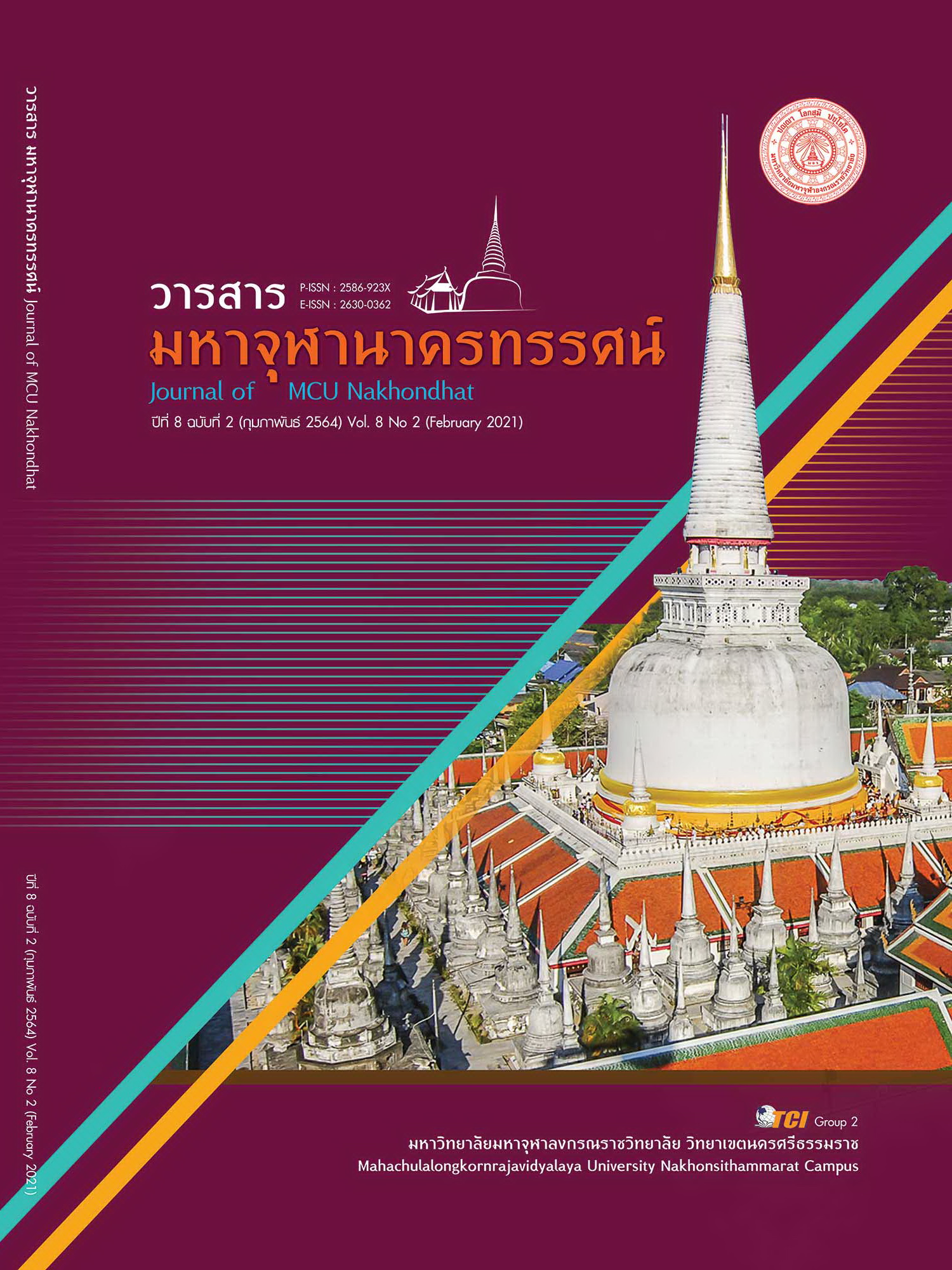THE PERFORMANCE OF THAI FOLK MUSIC THAT EXPRESSES THE INHERITANCE OF LOCAL ARTS, CULTURES, AND TRADITIONS
Main Article Content
Abstract
The Objectives of this research article were to study the performance of Thai folk music that expresses the inheritance of local arts, cultures, and traditions, Is a document synthetic research Research tools are documents, books, textbooks, Internet journals and electronic databases. The data were collected from the recorded data for content analysis and data synthesis techniques were used by Primary analysis, Secondary analysis, Meta - analysis and study Thai folk music performances that show the inheritance of local arts, culture and traditions. The research results were found that 1) Northern region uses songs for their performances, such as Joy, Mae Mai Khom Which gives a feeling of softness, sweetness, showing the simple living and culture Carrying traditions such as Yi Peng Poy Sang Long Tradition There is a band and a solo play. Inherited, integrated with the network of schools across the country. 2) The central region used music for performances such as the song Thep Thong Lamat, arts that are consistent with lifestyle. Play for joy Perform a ritual And played for communication It has been developed in a manner combined with royal music. It has evolved from drum and drum music to xylophone and gong. Use local curriculum to spread the word to youth and community. And invited local scholars in music to teach 3) Southern region uses songs for performances such as the song of the boat song, Like Hulu boat, showing the art of dancing and the performance of Thai Buddhist culture. And Thai Muslim culture Inherit the limestone play According to beliefs and rituals 4) Northeast The songs are also used in performances as well. Trum Mor Lam is used to perform rituals and beliefs, such as the Biao Xiao tradition Boon Bang Fai Tradition.
Article Details
References
ณัฐพจน์ โพธิ์เจริญ. (2559). การสืบทอดและอนุรักษ์ดนตรีของกลุ่มชาติพันธุ์ลาวเวียงตำบลดอนคาอำเภออู่ทอง จังหวัดสุพรรณบุรี. วารสารมนุษยศาสตร์และสังคมศาสตร์มหาวิทยาลัยราชภัฏอุบลราชธานี, 7(1), 9-23.
นพรัตน์ ลาภส่งผล. (2563). ดนตรีไทยพื้นเมือง. กรุงเทพมหานคร: ม.ป.พ.
ภิญโญ ภู่เทศ. (2559). การอนุรักษ์และพัฒนาวัฒนธรรมดนตรีพื้นบ้านโดยใช้ชุมชนเป็นฐานของการเรียนรู้. วารสาร มจร สังคมศาสตร์ปริทรรศน์, 5(3), 233-242.
มหาวิทยาลัยมหาสารคาม. (2563). การถ่ายทอดการบรรเลงดนตรีและศิลปวัฒนธรรมวงโปงลางเพื่ออนุรักษ์ และพัฒนาภูมิปัญญาพื้นบ้านอีสาน. มหาสารคาม: มหาวิทยาลัยมหาสารคาม.
ยะพา เจะนิ และคณะ. (2557). บทบาทเพลงพื้นบ้านดิเกร์ฮูลูในการเสริมสร้างสันติสุขในสามจังหวัดชายแดนภาคใต้. ยะลา: มหาวิทยาลัยราชภัฏยะลา.
ศิลปชัย กงตาล. (2559). ดนตรีพื้นบ้าน. นครปฐม: มหาวิทยาลัยราชภัฏนครปฐม.
ศูนย์ประสานการปฏิบัติที่ 5 กองอำนวยการรักษาความมั่นคงภายในราชอาณาจักร. (2563). สืบสานศิลปะการแสดงพื้นบ้านเพื่อสันติสุข. กรุงเทพมหานคร: ศูนย์ประสานการปฏิบัติที่ 5 กองอำนวยการรักษาความมั่นคงภายในราชอาณาจักร.
สันดุสิทธิ์ บริวงษ์ตระกูล. (2559). การสืบทอดสื่อพื้นบ้านหมอลำเรื่องต่อกลอน. วารสารกระแสวัฒนธรรม, 17(32), 81-90.
อามีเนาะ ยาสาแล และคณะ. (2555). บทบาทเพลงพื้นบ้านดิเกร์ฮูลูในการเสริมสร้างสันติสุขในสามจังหวัดชายแดนภาคใต้. ยะลา: มหาวิทยาลัยราชภัฏยะลา.


